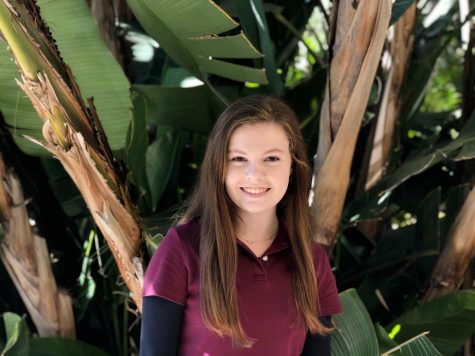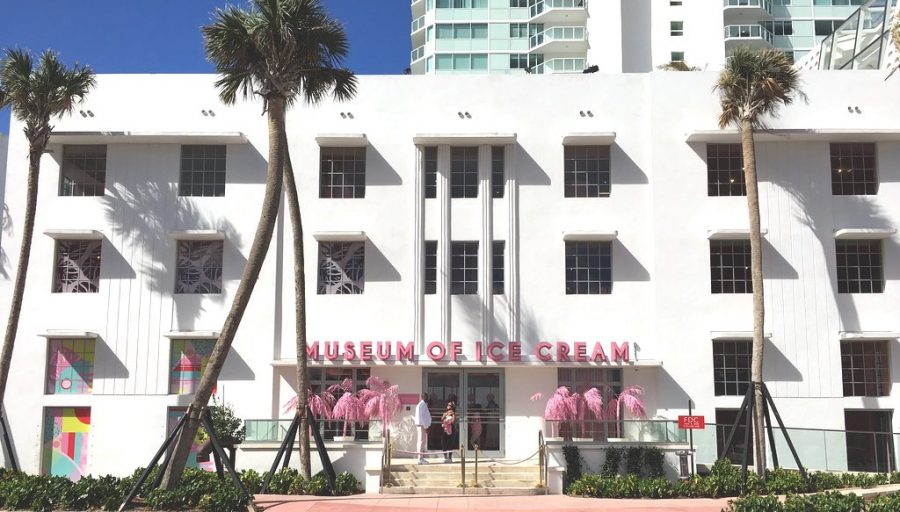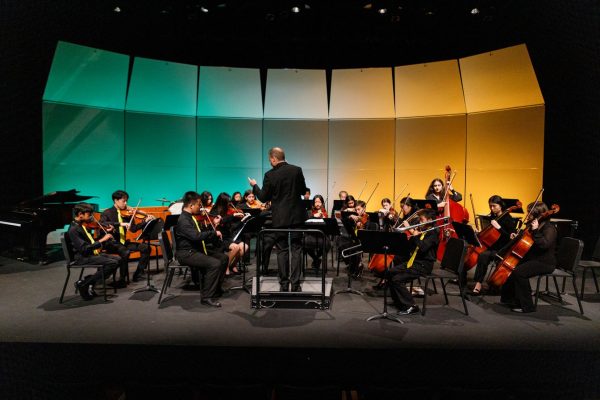Seeing is Believing: The Museum Experience in the Digital Age
Photo courtesy of Phillip Pessar
The Museum of Ice Cream, originally a summer pop-up, now has permanent locations such as this one in Miami.
‘Aesthetic’: an adjective, defined by the Oxford English Dictionary as “made in an artistic way and beautiful to look at.” Its use first spiked in July 2014, according to the Urban Dictionary, and since has continued along its trajectory; the word has evolved in connotation, becoming not only an adjective but a noun. An ‘aesthetic’ is now a set of cohesive artistic principles to apply in daily life. Clothing, accessories, sayings and mannerisms, personal interests — all shape the aesthetic of an individual. Such careful curation may be hard to come by, but modern artists and entrepreneurs have collaborated to create Instagram-worthy dreamscapes just interesting enough to surpass theme park status and become museums. Meet the experium.
Experiums—the name a play on ‘experiential museums’—are places where the museum itself is the art. Their rooms are decked out floor to ceiling, often with features for guests to interact with. Maryellis Bunn, the founder of one of the original and most well-known experiums, the Museum of Ice Cream (MOIC), coined the term. MOIC started off as a pop-up in the summer of 2016; thanks to social media demand, it now has permanent locations in New York and San Francisco, plus additional pop-ups in Los Angeles and Miami.
Since MOIC’s first signs of success, dozens of other experiums have popped up across the world, mostly concentrated in urban cities and tourist destinations like New York City, Los Angeles, and London. Examples include the Museum of Pizza, Happy Place, Refinery 29’s 29Rooms, The Color Factory, Candytopia, Dream Machine, and Teamlab Borderless.
However, with the increasing internet popularity of the experium also comes repercussions: namely, cellphones.
Most experiums are intended to be art installations. San Diego’s own Wonderspaces, an art experience that has returned for the last few summers, features various artists who use texture and digital design uniquely—and often interactively—to fill spaces. While many visitors surely attend Wonderspaces to see the art, the allure of a good Instagram post never hurts.
Unless, for some artists like Bunn, that allure is too much. Being one of the first great experiums, MOIC attracted international attention and brought thousands of guests. More often than not, however, art experts critique it not as an art installation à la Wonderspaces, but as a place that capitalized off the perceived need by some for good Instagram content. The Atlantic’s Lauren Smiley said, “It is as if Willy Wonka had redesigned his factory for the selfie age.” The New York Times’ Katie Rogers deemed it a “spectacle worthy of the finest Instagram filter.”
The intention behind experiums, particularly brand-created pop-ups, is becoming increasingly focused on trends rather than on art or education like a traditional museum. Spotify created its own pop-up spaces for different celebrities such as Ariana Grande and Billie Eilish, with rooms inside corresponding to different music videos or iconic outfits. Rather than learn new information, as one might in a real museum, or interact with features, as one might in earlier experium variations, guests can walk through the rooms and simply look around—and if they feel inclined, snap a few photos of their surroundings.
The reputation of being ‘aesthetic’ or Instagram-worthy is never one that Bunn had in mind; in fact, it’s one she’s actively working to defy. She said, “In the experience, the more you participate—that is play, taste, meet strangers, engage with our guides, sing, dance, swim—the more you get out of it.” In her eyes, phones detract from those positives.
To combat this problem, MOIC has started implementing no phone days. At the door, guests will not only fill out their waivers but check their phones for the remainder of the experience.
Bunn said to Bloomberg, “Science clearly shows that even having your phone in your pocket creates a distraction, making you less present in an experience. We have tested engagement in our ‘No Phone Days,’ and happiness and satisfaction are significantly higher without phones.”
“The no phone days are a cornerstone of our mission to create spaces where people can truly connect once again,” she said in the podcast Happiness Lab.
Even so, are experiums all bad? Some would argue that the ‘Instagrammability’ of a work does not lessen its value. “Have we not clamored for spectacle for thousands of years?” said an experium creator Nicholas Bell to The Atlantic. “People like large things that overpower them in some way. I think it’s part of human nature.”
The Atlantic’s Katharine Schwab continued, “Shows feature big, bold, spectacular works that translate into showy Instagram pictures or Snap stories, allowing art to wow people who might otherwise rarely set foot inside museums.” The less pretentious the work, the more accessible it is to the general population, many of whom rely on social media to experience art anyways.
To decide for yourself, San Diego’s The Cado, an experium dedicated to avocados, will return to a currently-undecided location in San Diego this June. Additionally, Wonderspaces will return to San Diego March 1 through 31 at Liberty Station with a critically acclaimed exhibit on virtual-reality film that has been featured at Sundance and Tribeca Film Festivals.

Amy Carlyle is a senior and Editor-in-Chief of The Tower. She came to Bishop’s as a sixth grader and joined the staff at the start of her freshman year....



![Leia (‘30) and Sara Park (‘32) ended their combative performance with a yell known as a kiyap. Leia explained with a proud smile, “I realized this when I was little, but not many people see taekwondo every day. For me, it’s a daily occurrence, so it feels very normal…when I do [a performance] in public, everyone’s like ‘Wow, that’s really cool’. So it always reminds me how this isn’t a normal thing in other people’s lives and I think it’s really cool that I can share that.”](https://thebishopstower.com/wp-content/uploads/2025/10/Screenshot-2025-10-02-at-2.07.47-PM-600x583.png)



